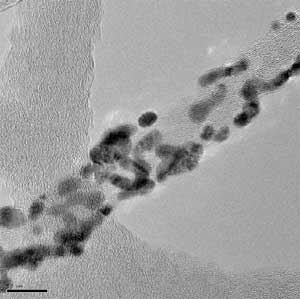| Posted: Jan 15, 2007 | |
Towards a high performance nanotechnology glucose sensor for diabetes sufferers |
|
| (Nanowerk Spotlight) As the most common endocrine metabolic disorder for human beings, diabetes mellitus with an obvious phenomenon of high blood glucose concentrations results from a lack of insulin. Despite the availability of treatment, diabetes has remained a major cause of death and serious vascular and neuropathy diseases. Continuously monitoring the blood glucose level and intermittent injections of insulin are widely used for effective control and management of diabetes. Extensive research has been conducted to develop optimal glucose sensors for diagnostic purposes. Currently, the commercially available glucose biosensors still have some problems to overcome, such as time consuming, relatively low sensitivity, bad reliability. The performance of a glucose sensor is largely dependent upon the materials which construct the sensor. Recent research effort for glucose sensing have turned to on nanomaterials. Nanomaterial-based biosensors already have shown the capability of detecting trace amounts of biomolecules in real time. New research has studied the electrochemical characteristics of platinum decorated carbon nanotubes (CNTs) as a promising candidate for glucose sensing. Its improved performance may encourage further exploration of this novel nanomaterial in the field of bioapplications. | |
| "The good electrochemical properties for both carbon nanotubes and platinum nanoparticles have been well documented" Dr. Jining Xie explains to Nanowerk. "However, there are few reports on combining both. The originality of our work is to in-situ prepare platinum decorated carbon nanotubes, not simple mixing them, as the supportive materials for glucose sensing electrodes." | |
| The researchers used platinum decorated multi-walled CNTs to prepare an enzyme-based mediated glucose sensor. Compared with the bare MWNT-based sensor, the Pt/MWNT paste-based glucose sensor exhibits a substantially higher sensitivity. | |
| Xie, a research scientist in charge of the Nanomaterials and Carbon Nanotube Laboratory at the University of Arkansas' High Density Electronics Center, points out that an obvious potential application of his team's work is for fast, sensitive and considerably reliable glucose sensing. Such precise detection of glucose level and continuous monitoring its fluctuation throughout the day could be a significant improvement of diabetes control and its management. | |
 |
|
| High resolution TEM images of platinum decorated carbon nanotubes (scale bar: 10 nm) (Reprinted with permission from Institute of Physics) | |
| The morphology and size of CNTs make them an ideal supporting material for heterogeneous catalysts. Decoration of CNTs is of great interest to modify the properties of pristine CNTs for versatile applications. Nanotubes attached with noble metal nanoparticles are a type of novel nanotube/nanoparticle hybrid material for heterogeneous catalysis, which could find promising application as nanoelectrodes in the next generation of high performance fuel cells and batteries. | |
| "The efficient attachment of platinum nanoparticles to the nanotube surface enhances the electron transfer and offers a high surface area for enzyme loading" says Xie. "Prompted by the fact that the dimensions of nanomaterials are analogous to those of biological entities, we had the motivation to conduct this work to investigate the interaction between nanomaterials and biomolecules. Also, we aimed to explore the role which nanomaterials play during the electrochemical sensing process and try to understand the underling sensing mechanism on a nanoscale level." | |
| After platinum decoration of the CNTs, a larger electroactive surface area was obtained, which may have two advantages in glucose sensing. Firstly, due to its large surface area, platinum decorated multi-walled CNTs act as a glucose oxidase (GOx) reservoir which is helpful for uniform immobilization and high loading of GOx for glucose sensing. Secondly, the large surface area may lead to higher selectivity for glucose sensing because it favors a kinetically controlled reaction over reaction from diffusion-controlled interfering electroactive species, such as ascorbic acid, uric acid and pacetamedophenol. | |
| Xie cautions that there are still several issues left for his team to further optimize their glucose sensor. "For instance, the response time needs to be improved" he says. "To do so, systematic research is required to optimize the materials components and adjust their characteristics. Meanwhile, the cost of nanomaterials is another unavoidable issue for future possible commercialization. Large scale production of nanomaterials could be achieved in the near future and lower the cost for glucose sensing devices." | |
| Xie's latest findings have been reported in Nanotechnology "Platinum decorated carbon nanotubes for highly sensitive amperometric glucose sensing". | |
 By
Michael
Berger
– Michael is author of three books by the Royal Society of Chemistry:
Nano-Society: Pushing the Boundaries of Technology,
Nanotechnology: The Future is Tiny, and
Nanoengineering: The Skills and Tools Making Technology Invisible
Copyright ©
Nanowerk LLC
By
Michael
Berger
– Michael is author of three books by the Royal Society of Chemistry:
Nano-Society: Pushing the Boundaries of Technology,
Nanotechnology: The Future is Tiny, and
Nanoengineering: The Skills and Tools Making Technology Invisible
Copyright ©
Nanowerk LLC
|
Become a Spotlight guest author! Join our large and growing group of guest contributors. Have you just published a scientific paper or have other exciting developments to share with the nanotechnology community? Here is how to publish on nanowerk.com.
